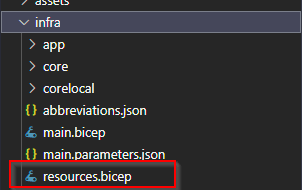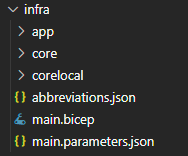⚠ Advice This blog post is part of a journey with the Azure Developer CLI and the journey has started two blog posts earlier - in case you missed them it might make sense to shortly catch-up otherwise this one might be a bit out of context.
You find the previous editions in the table of contents above 👆
Introduction
With the updates of the Azure Developer CLI to version 0.3.0-beta3 and finally 0.4.0-beta.1 (2022-11-02) simplifications were introduced that affect the structuring of the bicep templates. The overall layout was simplified and the bicep templates from the core library have been re-structured and improved..
📝 Remark: The setup presented here is also valid with the CLI version 0.4.0-beta.1.
What has changed
We start with the setup that was state-of-the-art with version 0.2.0-beta.2 and take it from there.
devcontainer.json
Change in the setup of the devcontainer.json. The deprecated syntax of the feature description is updated and references the features via https://github.com/devcontainers
This brings us from here:
"features": {
"github-cli": "2",
"azure-cli": "2.40",
"docker-from-docker": "20.10",
"node": {
"version": "16",
"nodeGypDependencies": false
}
}
to the new setup:
"features": {
"ghcr.io/devcontainers/features/azure-cli:1": {
"version": "2.40"
},
"ghcr.io/devcontainers/features/docker-from-docker:1": {
"version": "20.10"
},
"ghcr.io/devcontainers/features/github-cli:1": {
"version": "2"
},
"ghcr.io/devcontainers/features/node:1": {
"version": "16",
"nodeGypDependencies": false
}
}
The infrastructure setup
The main new hot stuff for me is the restructuring of the .bicep infrastructure. Yes they did it again, and I like what they did, as it makes my setup easier and improves the transparency what happens without too many hops due to layers of abstraction. The restructuring has some impact: compared to the prior version there are now:
- new/different templates with new/different parameters
- a new file structure
📝 Remark: there are also new
.bicepfiles due to completely new templates (like the C# one).
So as in the prior restructurings of the infrastructure setup I created the Static Web App (SWA) sample for Node.js as a blueprint in a different folder. I copied the new core folder, as well as the abbreviations.json and the main.parameters.json into my existing project. After that I copied the main.bicep from my old setup. But wait, isn't there a file missing? Yes and that is one main difference in the new setup compared to prior versions: there is no resources.bicep file any more. Everything has moved to main.bicep.
The old structure looked like this:
while the new one has this setup now:
📝 Remark: Time will show if this is a good approach for complex projects or not. Having said that, this is of course an optional change, you can leave the structure as is, if this is beneficial for your use case.
Now we have a mixed setup with my files from azd version 0.2.0-beta.2, i.e., the app and the corelocal folder with my extensions specific for my use case.
Following the approach of putting everything into the main.bicep which at least for my sample setup it makes life easier, I copy all the resource definitions form the old resources.bicep into the main.bicep - brute force style. That meant: Welcome to the universe of the curly red underlines as of course this file is far from being a valid .bicep file.
After breaking it, let's fix it. I started with the low-hanging fruits by copying the app-agnostic building blocks from the SWA sample to my main.bicep. This comprises:
- the header with new/additional parameters
- the new resource group definition
- the monitoring part
- the Azure Key Vault part
As the referencing of several parameters pointed in the wrong direction due ot the copy&paste action, I had to adjust several parameters like the ones of the Azure Key Vault. This was straight forward and went smooth due to the type-ahead support of the bicep extension for VSCode. After that at least some parts of the main.bicep became valid again.
📝 Remark: When you do the migration, I recommend to take a look at the new naming conventions for the parameters of the different modules. This is consistent over all files and makes a more flexible setup of your resources possible. We will see that in a second.
One additional point that changed in the setup is that the Azure Key Vault access is now an explicit part of the sample setup using the keyvault-access.bicep module. This module was already available in the prior versions but was not used. To the Azure Key Vault comprises two blocks:
// Store secrets in a keyvault
module keyVault './core/security/keyvault.bicep' = {
name: 'keyvault'
scope: rg
params: {
name: !empty(keyVaultName) ? keyVaultName : '${abbrs.keyVaultVaults}${resourceToken}'
location: location
tags: tags
principalId: principalId
}
}
// Give the API access to KeyVault
module apiKeyVaultAccess './core/security/keyvault-access.bicep' = {
name: 'api-keyvault-access'
scope: rg
params: {
keyVaultName: keyVault.outputs.name
principalId: function.outputs.FUNCTION_IDENTITY_PRINCIPAL_ID
}
}
This sample also reflects the clean naming conventions for the resources and the parameters that are consistent over all .bicep modules.
The setup of the App service plan as well as for the storage attached to the Azure Function is straightforward and I took that from the SWA sample.
With that we can move to the specifics of the sample Azure Function I am using:
- one additional dedicated storage account with a Blob storage container
- a secret in the Azure Key Vault for accessing the Blob storage from the Azure Function
Due to some restrictions in the previous azd version, I had to create my own .bicep module for the storage as I could not create a storage with a new name. There was also no option to specify a container within a storage account. With the new azd version this is possible. This means that I can get rid of my custom built modules and use the modules from the core folder provided by azd. The new setup of my additional storage account looks like this:
// Second Storage Account for Output Binding
module outputstorage './core/storage/storage-account.bicep' = {
name: 'outputstorage'
scope: rg
params: {
name: blobStorageForPlayersName
location: location
tags: tags
containers: [
{
name: storageContainerName
}
]
}
}
That's cool and gives me a leaner setup.
The definition of the secret is not (yet) part of the core modules delivered by Microsoft, so I sticked to my existing custom module from the prior setup. To be consistent I aligned the parameters with the one of the core modules, so the new keyvault-blobaccess-secret.bicep looks like:
param name string
param tags object = {}
param keyVaultName string
param blobStorageName string
resource keyVault 'Microsoft.KeyVault/vaults@2022-07-01' existing = {
name: keyVaultName
}
resource playerStorage 'Microsoft.Storage/storageAccounts@2021-09-01' existing = {
name: blobStorageName
}
resource keyVaultSecret 'Microsoft.KeyVault/vaults/secrets@2022-07-01' = {
name: name
tags: tags
parent: keyVault
properties: {
contentType: 'string'
value: 'DefaultEndpointsProtocol=https;AccountName=${playerStorage.name};AccountKey=${playerStorage.listKeys().keys[0].value};EndpointSuffix=core.windows.net'
}
}
This leads to the following entry in the main.bicep:
/attach output storage to keyvault
module outputStorageSecret './corelocal/security/keyvault-blobaccess-secret.bicep' = {
name: 'keyVaultSecretForBlob'
scope: rg
params: {
name: blobStorageSecretName
tags: tags
blobStorageName: outputstorage.outputs.name
keyVaultName: keyVault.outputs.name
}
}
Finally the /app/function.bicep needed to be cleaned up to reference the new single .bicep module for Azure Functions:
param name string
param location string = resourceGroup().location
param tags object = {}
param allowedOrigins array = []
param applicationInsightsName string = ''
param appServicePlanId string
param appSettings object = {}
param keyVaultName string
param serviceName string = 'blob-output-binding'
param storageAccountName string
module function '../core/host/functions.bicep' = {
name: '${serviceName}-functions-node-module'
params: {
name: name
location: location
tags: union(tags, { 'azd-service-name': serviceName })
allowedOrigins: allowedOrigins
alwaysOn: false
appSettings: appSettings
applicationInsightsName: applicationInsightsName
appServicePlanId: appServicePlanId
keyVaultName: keyVaultName
runtimeName: 'node'
runtimeVersion: '16'
storageAccountName: storageAccountName
}
}
output FUNCTION_IDENTITY_PRINCIPAL_ID string = function.outputs.identityPrincipalId
output FUNCTION_NAME string = function.outputs.name
output FUNCTION_URI string = function.outputs.uri
As you can see no more language-specific templates. I like that approach as I think it is more transparent for the developer without the drawback to make the developer drown in unnecessary complexity. From my point of view the prior setup although hiding some parameters was more cumbersome.
The new parameters need to be reflected in the main.bicep. The corresponding section looks like this:
// The function app
module function './app/function.bicep' = {
name: 'function'
scope: rg
params: {
name: !empty(functionName) ? functionName : '${abbrs.webSitesFunctions}api-${resourceToken}'
location: location
tags: tags
applicationInsightsName: monitoring.outputs.applicationInsightsName
appServicePlanId: appServicePlan.outputs.id
keyVaultName: keyVault.outputs.name
storageAccountName: storage.outputs.name
appSettings: {
BLOB_STORAGE_CONNECTION_STRING: '@Microsoft.KeyVault(SecretUri=${keyVault.outputs.endpoint}secrets/${blobStorageSecretName})'
}
}
}
And that was it - everything is up and running again proven by a simple azd up!
More news
Over the last releases some more improvements have been made (like azd configure), you find a complete overview in the following blog posts:
Summary
It is great to see the continuos improvements around the Azure Developer CLI. Especially the infrastructure part is continuously moving forward and the usability as well as the developer experience is improving in every iteration (at least this is my experience).
Looking forward to the next iterations of the tool!
Where to find the code
You find the code and the description of the project here (mind the branch):
https://github.com/lechnerc77/azd-compatibility-azure-function/tree/azd-040-beta1
The latest and greatest project code is in the main branch which might deviate from the code described in this blog post.
Useful references
Useful references if you want to try things out on your own:
- azd documentation
- azd on GitHub
- bicep documentation
- bicep playground
- Azure Developer CLI (azd) – September 2022 Release - information and links for Terraform
- Azure Developer CLI (azd) – October 2022 Release
- Azure Developer CLI (azd) – November 2022 Release
- QuickGlance - Azure Developer CLI
- The Azure Developer CLI - Compatibility journey for an Azure Functions Project
- Azure Developer CLI - How does it know that?





Top comments (0)